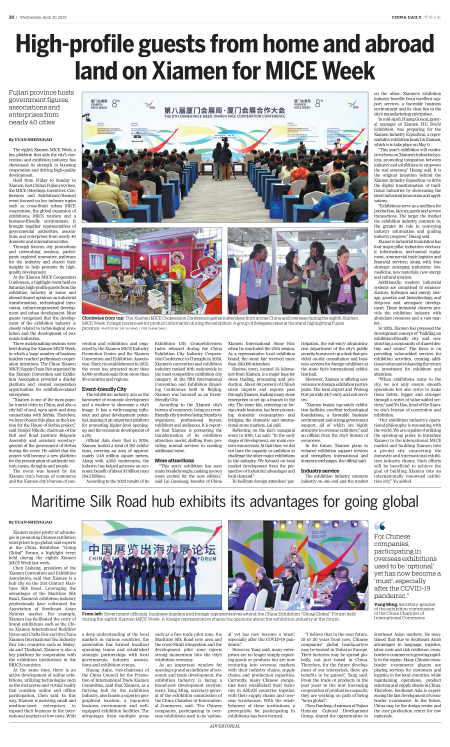
From left: Government officials, business insiders and foreign representatives attend the China Exhibition "Going Global" Forum held during the eighth Xiamen MICE Week. A foreign representative shares his opinions about the exhibition industry at the forum.

Xiamen enjoys plenty of advantages in promoting Chinese exhibition enterprises to go global, said experts at the China Exhibition "Going Global" Forum, a highlight event held during the eighth Xiamen MICE Week last week.
Chen Lisheng, president of the Xiamen Convention and Exhibition Association, said that Xiamen is a hub city on the 21st Century Maritime Silk Road. Leveraging the advantages of the Maritime Silk Road, Xiamen's exhibition industry professionals have cultivated the Association of Southeast Asian Nations market. For example, Xiamen has facilitated the entry of brand exhibitions such as the China Xiamen International Buddhist Items and Crafts Fair and the China Xiamen International Tea Industry Fair into countries such as Malaysia and Thailand. Xiamen is also a key platform for cooperation with the exhibition institutions in the BRICS countries.
At the same time, there is an active development of online exhibitions, utilizing technologies such as the metaverse and virtual reality that combine online and offline participation, Chen said. In this way, Xiamen is assisting small and medium-sized enterprises to expand their business in the international markets at low costs. With a deep understanding of the local markets in various countries, the association has formed localized operating teams and established strategic partnerships with local governments, industry associations and exhibition venues.
Huang Anjie, vice-chairman of the China Council for the Promotion of International Trade Xiamen Committee, said that Xiamen, as a thriving hub for the exhibition industry, also boasts a superior geographical location, a top-notch business environment and well-equipped exhibition facilities. The advantages from multiple areas such as a free trade pilot zone, the Maritime Silk Road core area and the cross-Strait integration and the development pilot zone injects strong momentum into the city's exhibition economy.
As an important window for opening-up and an indicator of economic and trade development, the exhibition industry is facing a brand-new development environment. Yang Ming, secretary-general of the exhibition commission of the China Chamber of International Commerce, said: "For Chinese companies, participating in overseas exhibitions used to be 'optional' yet has now become a 'must', especially after the COVID-19 pandemic."
However, Yang said, many enterprises are no longer simply exporting goods or products but are now venturing into overseas markets with their industry chains, supply chains and production capacities. Currently, many Chinese companies have established their factories in ASEAN countries together with their supply chains and overseas warehouses. With the establishment of these institutions, a prerequisite for participating in exhibitions has been formed.
"I believe that in the near future, 10 or 20 years from now, Chinese companies' global headquarters may be located in Dubai or Europe. Their factories may be spread globally, not just based in China. Therefore, for the future development of our enterprises, there are benefits to be gained," Yang said. From the trade of products in the past years to the now increasing cooperation of production capacity, they are working on path of being "born global".
Chen Danfeng, chairman of Fujian Huiyuan Cultural Development Group, shared the opportunities in Southeast Asian markets. He mentioned that due to Southeast Asia's advantages in language, logistics, labor costs and risk resilience, cross-border e-commerce is growing rapidly in the region. Many Chinese cross-border e-commerce players are placing services for customers and logistics in the local countries, while maintaining operations, product selection and supply chains in China. Therefore, Southeast Asia is experiencing the fast development of cross-border e-commerce. In the future, China may be the design center and the core production center for raw materials.

